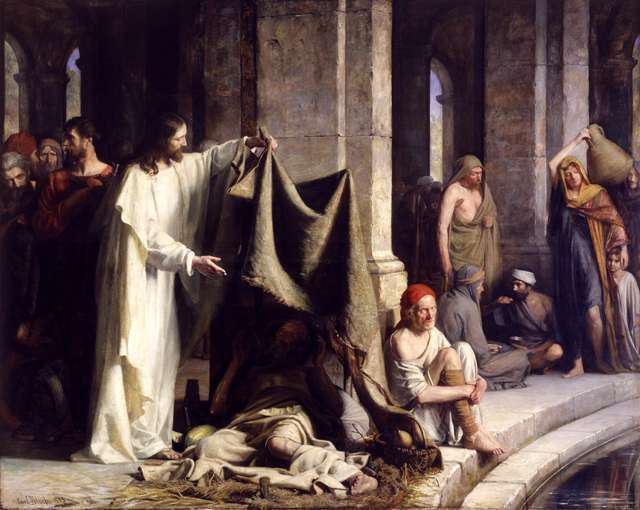Christ Healing the Sick at Bethesda

CARL HEINRICH BLOCH (1834–1890)
This altarpiece depicts one of Christ’s miracles from the Gospel of John—the healing of an infirm man at the Pool of Bethesda in Jerusalem. Christ reaches out to the helpless man who lies beneath a coarse canopy near the healing waters. The amazed expression on the man’s face, not used to the attention now afforded him by this Healer from Nazareth, is obscured by shadow. Though this crippled man is a focus of the scriptural account, the light rests upon both Christ and the red-turbaned man who sits on the stone steps beside the pool and stares at the viewer with a confrontational gaze. Perhaps the man’s piercing gaze is meant to thwart others who would enter the pool before him; or perhaps, somewhat embittered, he looks askance at the impending miracle, begrudging its recipient and his own unresolved plight. Whatever his motives, his direct gaze acknowledges the onlooker as a participant in the story.
The painting displays the studied naturalism, detail of textures, rich colors, and masterful effects of light and shadow championed by the traditional art academies of Europe during much of the nineteenth century. Far from being sterile or dispassionate in its technical precision, the painting creates an episode that offers compelling insights into the scriptural account. Carl Bloch studied at the Royal Danish Academy in Copenhagen and later traveled to Rome to study the great works of the Italian masters. Bloch maintained integrity to the academic classical style throughout his career.
Curricular Resources
The MOA has created suggested discussion prompts and assignments for BYU CIV faculty and students to use. Each assignment is based on themes that correspond with GE learning outcomes.
View Curricular Resources Related to This Work:
19th Century Man and Divine